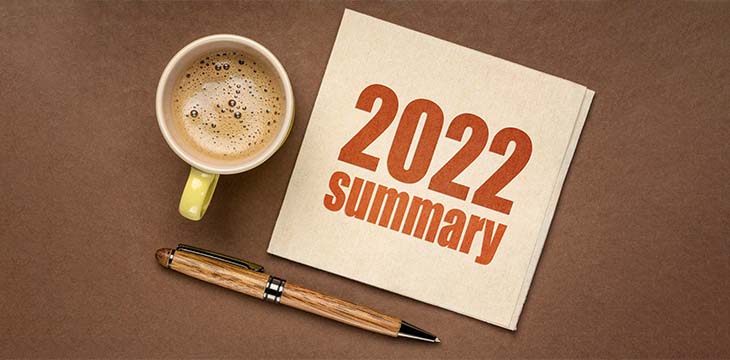|
Getting your Trinity Audio player ready...
|
2022 has been a fascinating year for digital asset regulation.
Anyone paying attention knew going into the year that it would be a big one for regulators and law enforcement looking to reel in the industry. Many of those aware of this will also have been cautiously waiting for the day when one of the industry’s many ticking time bombs detonate, though trying to predict precisely which bomb would go first and when it would happen was fool’s gold.
None, however, could have predicted the two events coinciding so spectacularly.
It’s not just that FTX, the world’s fourth-biggest (and arguably second-most recognizable) exchange, was revealed to be as audacious and gargantuan of a fraud as the industry has yet seen at the tail end of a year where regulators and law enforcement had finally begun to get a grip on digital assets and the various scams they entail.
Nor is it that the FTX disaster perfectly bookends a year that began with a cast of celebrities appearing in multi-million dollar Super Bowl ads to lure more people into the industry.
It’s that FTX founder Sam Bankman-Fried went out of his way to court D.C. lawmakers and shape the regulatory wave. The more that gets revealed about what was going on at FTX under Bankman-Fried’s direction, the more it looks like this was a practice calculated to pull the wool over regulators’ eyes.
Ironically, FTX’s collapse might have provided the final imperative necessary for global lawmakers to answer the digital asset question once and for all.
Regulatory scrutiny is now likely to turn to any other FTXs which remain within the digital asset industry. Atop their list is likely to be Binance and its founder Changpeng Zhao, whose role in the FTX collapse has sparked questions of monopolistic practices, as well as over Binance’s own financial health.
Binance is already said to be under investigation by multiple regulators, and if the allegations contained in a bombshell Reuters investigation are to be believed, Binance is likely facing any number of enforcement actions.
Among these will be potential sanctions violations: according to Reuters, Binance has processed $8 billion worth of transactions from Iran since 2018; Iran is a sanctioned country. For context, Kraken was just forced to pay $362,000 to the Department of Justice to settle a case over a mere $1.6m worth of sanctioned transactions – and that was with Kraken’s self-reporting.
One question concerning U.S. digital asset regulation repeatedly bubbled to the surface throughout the year: which regulator should have prime authority over the digital asset industry? The two obvious candidates are the Securities and Exchange Commission (SEC) and the Commodity Futures Trading Commission (CFTC), both of whom have made concerted efforts to step up their enforcement of the digital asset industry.
Both have a stake in the question for different reasons: the SEC is responsible for securities, and so to the extent that a digital asset can be said to amount to a security, it will be subject to U.S. securities laws and the SEC. The CFTC is responsible for commodity-based futures and derivatives markets rather than spot markets: the Commission has said it views BTC and other digital assets as commodities and therefore claims authority over their trading.
But the boundaries between the two agencies are unclear, and it’s fair to ask whether a single regulator might better serve the market. Legislation currently before U.S. Congress, the Digital Commodities Consumer Protection Act (DCCPA), would give the CFTC exclusive jurisdiction over digital commodities trading. It would also afford the CFTC powers of oversight and surveillance on a similar level to the SEC, meaning the CFTC does not have to primarily rely on whistleblowers to bring enforcement.
As for the SEC, at the end of 2021, chair Gary Gensler vowed to crack down on the ‘wild west’ of digital assets. Now at the end of 2022, Gensler proved he can put his money where his mouth is. The SEC announced in November that the regulator had set a new record for enforcement penalties, collecting a staggering $6.4 billion from 760 actions across the year. It amounts to a 67% increase from the previous year.
One of the SEC’s earlier targets is still trying to wiggle its way out of regulatory enforcement. The long-standing case against Ripple has drawn a lot of comment, with critics accusing the SEC of ‘regulation by enforcement’ in bringing an action over XRP, which the SEC says amounted to an unregistered securities offering.
One of the defenses Ripple is trying is the fair notice defense. In the U.S., an affirmative defense is available to a defendant if they can show they lacked fair notice that their conduct violated the law. This is a common feature in criticisms of the SEC’s approach to digital asset projects.
However, inconveniently for XRP, that very defense was rejected in another recent case over the offering of unregistered securities, the LBRY case. There, the court said:
“The SEC has not based its enforcement action here on a novel interpretation of a rule that, by its terms, does not expressly prohibit the relevant conduct. Instead, the SEC has based its claim on a straightforward application of a venerable Supreme Court precedent that has been applied by hundreds of federal courts across the country over more than 70 years.”
“While this may be the first time it has been used against an issuer of digital tokens that did not conduct an ICO, LBRY is in no position to claim that it did not receive fair notice that its conduct was unlawful.”
That case is still before the courts.
Elsewhere in the world, legislators in the United Kingdom kicked off the year by promising that more comprehensive digital asset regulation was on the agenda for 2022. Granted, that was two prime ministers ago, but the commitment has survived, and two Bills currently before Parliament would radically alter the legal landscape for digital assets in the country.
One is the Financial Services and Markets Bill, which aims to further integrate definitions for digital assets and digital asset service providers into existing statutes. For example, it allows ‘digital settlement assets’ to be designated by the U.K. Treasury as a recognized payment system, bringing it within the oversight of the Bank of England – but only if any deficiencies in the asset would likely threaten the stability of the U.K. financial system. It would also prohibit the promotion of digital assets without first obtaining a license from the U.K. Financial Conduct Authority.
The Bill is currently before Parliament and is not expected to pass before the end of the year.
The other is the Economic Crime and Corporate Transparency Bill, which is set to make it easier for law enforcement to force businesses to turn over information related to suspected money laundering and terrorist financing—and is set to include digital assets within its ambit.
Sticking in England for a moment: investors took the matter of unfair market manipulation into their own hands by filing a record-breaking £9.9 billion class action lawsuit with the U.K.’s Competition Appeal Tribunal. Around 240,000 BSV investors complain that four exchanges—Binance, Bittylicious, Kraken, and Shapeshift—conspired to damage the prospects of BSV by delisting the asset without good reason. Kraken and Binance are also accused of causing further losses by forcibly converting the BSV that investors were holding on the exchange into other currencies. According to the suit, these actions ‘reduced, prevented or distorted’ competition in the United Kingdom in violation of the Competition Act 1998.
Most importantly, the class is being represented by Lord David Corrie of Marylebone, who was the inaugural chair of the U.K.’s competition regulator. He said in a statement that he regards the case “as an opportunity to demonstrate that competition law applies in the sphere of crypto assets in the same way it does to other economic activities.”
The case is expected to be certified by the Competition Appeal Tribunal sometime next year.
Over on the continent, the European Commission has made stellar progress on its Markets in Crypto-Assets (MiCA) Bill, which has been in the oven since September 2020. The law is intended to bridge the remaining gaps in E.U. legislation created by the advent of digital assets.
One of the most critical aspects of the Bill is that it seeks to establish the powers that should be afforded to local authorities within E.U. jurisdictions so that they can better enforce new rules around digital assets. E.U. national regulators will be given the responsibility to issue licenses to digital asset entities and all the powers that authority entails, such as forcing non-compliant actors to suspend their services.
MiCA also has a lot to say about stablecoins: under MiCA, stablecoin issuers will be required to hold a 1:1 reserve of assets, while those holding the coins must be entitled to claim their true value from the issuer without charge.
Follow CoinGeek’s Crypto Crime Cartel series, which delves into the stream of groups—from BitMEX to Binance, Bitcoin.com, Blockstream, ShapeShift, Coinbase, Ripple,
Ethereum, FTX and Tether—who have co-opted the digital asset revolution and turned the industry into a minefield for naïve (and even experienced) players in the market.

 12-10-2025
12-10-2025 





